The Messages of the Bible (11 vols.)
Digital Logos Edition
Overview
In the Messages of the Bible series, the books of the Bible are grouped according to a natural classification, their contents arranged in order of appearance, and a scholarly yet popular paraphrase of their distinctive concepts given in plain, expressive English. Each volume is authored by a leading specialist, and each contains introductions and valuable notes for each portion of Scripture. This unique, popular commentary series is not a substitute for the Bible, but an aid to the reverent, appreciative, and enthusiastic reading of the Scriptures.
In the Logos Bible Software editions, all Scripture passages in the Messages of the Bible are tagged to appear on mouse-over. For scholarly work or personal Bible study, this makes these resources more powerful and easier to access than ever before. Perform powerful searches by topic or Scripture reference—finding, for example, every mention of “resurrection” or “Romans 6:5.”
This title is included in the following collections
You can save when you purchase this product as part of a collection.
2025 Leader Bronze Library
$89.99$76.492025 Leader Silver Library
$349.99$279.992025 Leader Gold Library
$849.99$679.992025 Ultimate Library
$23,999.99$17,999.99

- Scholarly paraphrase of the Old and New Testaments
- Introductions and commentary by leading specialists
- A unique and accessible biblical commentary
- Title: The Messages of the Bible
- Publisher: Charles Scribner’s Sons
- Volumes: 11
- Pages: 3,694
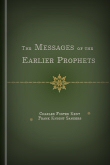
With Amos and Hosea, in the middle of the eighth century before Christ, began that notable succession of religious thinkers whose utterances have been given permanent form in the prophetic books of the Old Testament. As we know from their writings, they were men of remarkable breadth, insight, and power. While their greatest service to the world of their day, and for ours, was in the sphere of constructive religious thought, they were interested in the practical problems of human life, and touched it at many points. Their conviction that righteousness and sincerity were the fundamental elements of true life made them unsparing critics of social wrongs, idolatry, formalism, and worldliness; preachers of faith in God and love to man, and statesmanlike advisers on questions of public policy.
The Messages of the Earlier Prophets contains analysis and paraphrase of the following prophetic writings in the order of their original appearance:
- The Message of Amos
- The Message of Hosea
- The Earlier Prophetic Activity of Isaiah
- The Message of Micah
- The Later Prophecies of Isiah
- The Message of Nahum
- The Message of Zephaniah
- Jeremiah’s Prophetic Activity During the Reign of Josiah
- The Message of Habakkuk
- Jeremiah’s Activity During the Reign of Jehoiakim
- Jeremiah’s Activity During the Reign of Zedekiah
Charles Foster Kent (1867–1925) was born in Palmyra, New York, and educated at Yale, Yale Divinity School, and the University of Berlin. After working as an instructor at the University of Chicago and a professor of biblical literature and history at Brown University, he became Woolsey Professor of Biblical Literature at Yale University in 1901. He was a prolific author and editor, and his works include The Wise Men of Ancient Israel and Their Proverbs, Origin and Permanent Value of the Old Testament, Israel’s Laws and Legal Precedents, and Israel’s Historical and Biographical Narratives.
Frank Knight Sanders (1861–1933) received his PhD from Yale University in 1889 and was instructor in biblical literature and Semitic languages there from 1888 to 1891, then professor of biblical history and archaeology and dean of the divinity faculty at Yale University from 1901 to 1905. In 1908, he became the president of Washburn College in Topeka, Kansas. He was a member of the American Oriental Society, the Society of Biblical Literature and Exegesis, the Archaeological Institute of America, and the Religious Education Association, of which he was the first president. His works include The Teacher’s Life of Christ, Studies in the Apostolic Age, and Outlines for the Study of Biblical History and Literature.
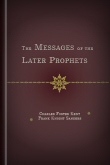
The beginning of the Babylonian exile marks a turning point in both Hebrew prophecy and history. The changed conditions and the new point of view gradually developed a new type of prophet. Although the distinctions between the earlier or preexilic and the later of exilic and postexilic prophets must be interpreted broadly, they are clearly defined. The aims of the two groups of teachers were the same, but the earlier spoke to a nation and dealt with the problems of an independent state, while the latter addressed the scattered, discouraged, often oppressed remnants of their people.
This volume completes the arrangement and analytical paraphrase of the prophetic writings of the Old Testament begun in The Messages of the Earlier Prophets. The Messages of the Later Prophets contains an analysis and paraphrase of the following prophetic writings in the order of their original appearance:
- Ezekiel, the Priest-Prophet of the Exiles
- Predictions of Ezekiel Concerning the Certain Fate of Jerusalem and Judah
- Prophecies of Obadiah and Ezekiel against Foreign Nations
- Jeremiah’s Message to the Jewish Fugitives in Egypt
- Ezekiel’s Messages of Comfort to the Exiles in Babylonia
- Ezekiel’s Vision of the Restored Hebrew State
- Songs of Exultation over Babylon’s Approaching Fall
- The Message of the Great Prophet of the Exile
- The Messages of Haggai and Zechariah to the Temple Builders
- Prophetic Messages of Encouragement in Connection with the Work of Nehemiah and Ezra
- The Message of Joel
- Messages of Promise to the Jews in the Greek Period
Charles Foster Kent (1867–1925) was born in Palmyra, New York, and educated at Yale, Yale Divinity School, and the University of Berlin. After working as an instructor at the University of Chicago and a professor of biblical literature and history at Brown University, he became Woolsey Professor of Biblical Literature at Yale University in 1901. He was a prolific author and editor, and his works include The Wise Men of Ancient Israel and Their Proverbs, Origin and Permanent Value of the Old Testament, Israel’s Laws and Legal Precedents, and Israel’s Historical and Biographical Narratives.
Frank Knight Sanders (1861–1933) received his PhD from Yale University in 1889 and was instructor in biblical literature and Semitic languages there from 1888 to 1891, then professor of biblical history and archaeology and dean of the divinity faculty at Yale University from 1901 to 1905. In 1908, he became the president of Washburn College in Topeka, Kansas. He was a member of the American Oriental Society, the Society of Biblical Literature and Exegesis, the Archaeological Institute of America, and the Religious Education Association, of which he was the first president. His works include The Teacher’s Life of Christ, Studies in the Apostolic Age, and Outlines for the Study of Biblical History and Literature.
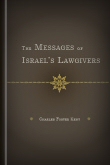
The Messages of Israel’s Lawgivers gives, in concise form, the origin, growth, date, and authorship of the different laws and groups of laws found in the Pentateuch. The laws, chronologically arranged, furnish a complete epitome of the growth of Israel’s moral standards. In the system of codification that Kent adopts, kindred laws have first been grouped together under seven main headings, and then, in order to bring out the historical development of each institution, those in each group or sub-group have been arranged in chronological order under the three general headings: “Primitive,” “Deuteronomic,” and “Priestly Codes.” Kent has divided the seven main sections of law under:
- Criminal Laws
- Private Laws
- Civil Laws
- Military Laws
- Humanitarian Laws
- Religious Laws
- Ceremonial Laws
Charles Foster Kent (1867–1925) was born in Palmyra, New York, and educated at Yale, Yale Divinity School, and the University of Berlin. After working as an instructor at the University of Chicago and a professor of biblical literature and history at Brown University, he became Woolsey Professor of Biblical Literature at Yale University in 1901. He was a prolific author and editor, and his works include The Wise Men of Ancient Israel and Their Proverbs, Origin and Permanent Value of the Old Testament, Israel’s Laws and Legal Precedents, and Israel’s Historical and Biographical Narratives.
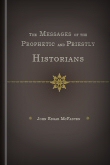
In accordance with the general purpose of the series to which it belongs, The Messages of the Prophetic and Priestly Historians aims at presenting the religious message of the historical books of the Old Testament in paraphrase. The wide outlook of its historians upon the progress of the centuries; their splendid interpretation of history; their triumphant faith in Israel’s mission and destiny; their overwhelming consciousness of God as the Lord of all, inspiring history with a sense of purpose, guiding it toward a divine event, bending to the consummation of his purpose the resources of the world which he created and controls, calling and equipping men from generation to generation to advance that purpose and to interpret his will, following his people in love through all their willful way, seeking, by a discipline which was often stern but always gracious, to bring them into that fellowship with himself for which man was originally destined: these are the things that are precious to the Christian church.
The Messages of the Prophetic and Priestly Historians includes the historical narratives of the Hexateuch, and also the entire books of Judges, Samuel, Kings, Chronicles, Ezra, Nehemiah, Ruth, and Esther in paraphrase with notes.
It is a reference book, which the student of the Old Testament will use constantly in his study as he uses Driver and Bacon and Kautzsch—to ascertain the prevailing partition of a passage among the sources according to the critical school.
—The Standard
John Edgar McFadyen (1870–1933) was a professor of language, literature, and Old Testament theology at the University of Glasgow in Scotland. His numerous works include Old Testament Criticism and the Christian Church, The Use of the Old Testament in the Light of Modern Knowledge, and The Wisdom Book in Modern Speech.
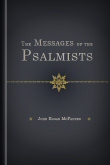
The Psalter will live as long as men are moved by the impulse to praise and pray. It anticipates and expresses the profoundest emotions of the spirit. Its simple, penetrating words have a strange power over the human heart, and, in the more solitary moods of the soul, it can touch to thoughts too deep for tears.
In The Messages of the Psalmists, John Edgar McFadyen has categorized the Psalms by subject and paraphrased them in the following chapters:
- Introduction
- Psalms of Adoration
- Psalms of Reflection
- Psalms of Thanksgiving
- Psalms in Celebration of Worship
- The Historical Psalms
- The Penitential Psalms
- The Royal Psalms
- Psalms Concerning the Universal Reign of Jehovah
- The Book of Lamentations
The arrangement is convenient, and it reveals the scope of the religious thought of the ancient Israelite when his soul was holding intercourse with God.
John Edgar McFadyen (1870–1933) was a professor of language, literature, and Old Testament theology at the University of Glasgow in Scotland. His numerous works include Old Testament Criticism and the Christian Church, The Use of the Old Testament in the Light of Modern Knowledge, and The Wisdom Book in Modern Speech.
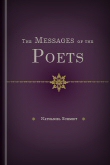
The Book of Job is one of the great masterpieces of world literature. No other work has come down to us from Hebrew antiquity that makes so strong an appeal to modern man by the problems fearlessly presented in it and its manner of approach to their solution. It is impossible to read the poem, even in a prose translation, without being impressed with its beauty of style, its grandeur of thought, and its deep moral earnestness.
Canticles, too, holds a unique place among the books of the Bible. It is manifestly not of a religious nature, in the ordinary sense of the word; and it does not, like Esther, deal with Israel, the people of Yahweh. Yet its position in the canon of Scripture has naturally led to various attempts to find in it a religious meaning, or at least what may be deemed a worthy moral purpose. Schmidt believes this is a mistake of flawed criticism, for the poems are to be taken as they are: an anthology of love lyrics, springing from the poet’s experience, and describing, with much charm and delicacy, the frankly sensuous and somewhat unconventional, yet none the less genuine, love of man and woman.
In The Messages of the Poets, Nathaniel Schmidt paraphrases and then analyzes the ethical and religious significance of Job and Canticles. Schmidt then explores 30 additional poems found in the Old Testament. Each poem is translated, a set of notes is supplied, and an exposition is given.
The present volume goes forth to a good service. It will enliven interest in biblical poetry. Scholars may have a difference of opinion on some of the primitive forms, but the impression created in the mind of the English reader by the literary ability of the religious poets of Israel will be beneficial in many ways.
—Biblical World
Nathaniel Schmidt (1862–1939) was professor of Semitic languages and literatures at Colgate University from 1888 to 1896 and later held the same position at Cornell University from 1896 to 1932. His numerous works include The Coming Religion, Ecclesiasticus, The Original Language of the Parables of Enoch, and Biblical Criticism and Theological Belief.
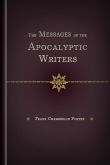
The books of Daniel and Revelation are rather a perplexity than a comfort to the average reader of the Bible. Some, indeed, in every age have taken delight in these books above all others just because of their mystery, but for the majority, apart from the impressive admonitions in the letters at the beginning of Revelation, and the glowing pictures of the New Jerusalem at the end, these have been sealed books. In quite recent times the historical method has, it’s not too much too say, broken the seals. To the historical student these apocalypses have become, in their general character and chief message, among the best—instead of the least—understood books of the canon. And their importance has grown with their understanding.
It is chiefly from the apocalypses, canonical and uncanonical, that we are to gain an understanding of the Jewish religion at the time of Christ. It is from these books that we are to get a true conception of the faiths and hopes, the motives and emotions of primitive Christianity. They are to serve as one of our chief helps to an understanding of the Pauline Christology, and even as our principal way of approach to that central and supreme problem of historian and theologian alike, the Messianic self-consciousness of Jesus himself.
The Messages of the Apocalyptic Writers contains the books of Daniel and Revelation and some uncanonical apocalypses rendered in paraphrase and with introductions and notes.
A very useful and convenient manual of Jewish and Christian apocalyptic from the historical point of view.
—Biblical World
An excellent manual. Professor Porter’s introduction to the study of these writings is done in a clear, systematic, and erudite manner. His tone throughout is scholarly and objective.
—Catholic World
In ample introductions and notes Professor Porter has given a confessedly obscure subject the lucid treatment it requires.
—Outlook
Frank Chamberlin Porter (1859–1946) was Winkley Professor of Biblical Theology at Yale Divinity School from 1891 to 1927. His works include A Statement of Christian Belief, Biblical and Semitic Studies, and The Mind of Christ in Paul.
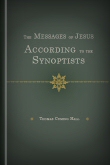
The Messages of Jesus According to the Synoptists contains the discourses of Jesus in the Gospels of Matthew, Mark, and Luke arranged in chronological order and freely rendered in paraphrase. The material of the teachings of Jesus are arranged systematically by the following chapters:
- Incidents Introductory to the Gospel Message
- The Work of John the Baptist
- the Introduction of Jesus to His Messianic Activity
- The Public Ministry of Jesus
- The Passion of Our Lord
- The Resurrection of the Christ
- Appendix
The volume of Professor Hall’s is one of the most important of these valuable series of books. Professor Hall’s paraphrase is sometimes very happy, and the book will be read with a new appreciation of the teaching of Jesus. His interpretations of the parables are especially to be commended. The references to literature are frequent, and on the whole catholic.
—Biblical World
Thomas Cuming Hall (1858–1936) graduated from Princeton University in 1879 and from Union Theological Seminary in 1882, and he was named professor of Christian ethics at Union Seminary in 1898. His works include The Power of an Endless Life, Social Solutions in the Light of Christian Ethics, and The History of Ethics within Organized Christianity.
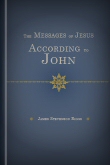
The Messages of Jesus According to John has a twofold aim. It seeks to give an interpretation of the Gospel and to set forth the Gospel’s peculiar structure and nature. These aims are accomplished by means of a paraphrase of the discourses of Jesus in the fourth Gospel, in which underlying connections of thought are supplied, figurative terms are explained, and such amplifications of the text are introduced to make the meaning more clear.
The Messages of Jesus According to John has been divided into the following areas of study:
- Introduction
- The Prologue and the Beginnings of the History
- The Public Ministry of Jesus
- Jesus and His Disciples
- The Passion
- The Resurrection
- The Epilogue
- Appendix
James Stevenson Riggs (1853–1936) was educated at the College Of New Jersey, Princeton Theological Seminary, and Auburn Theological Seminary. Riggs then served as adjunct professor of biblical Greek at Auburn Theological Seminary from 1884 to 1887. His works include What Shall I Believe?, A History of the Jewish People, and a commentary on 1 Corinthians.
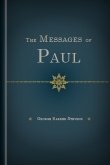
Some of the most important literature of antiquity exists in the form of letters. The correspondence of men prominent in political and literary life often throws a clear light upon the conditions of the age and reveals the forces, civic, social, and religious, which were operative in the time to which the letters belong. This volume comprises a paraphrase of the first 10 epistles of Paul, arranged in their probable chronological order, with brief introductions and analysis.
The Messages of Paul contains an analysis and paraphrase of the following Pauline epistles:
- The First Epistle to the Thessalonians
- The Second Epistle to the Thessalonians
- The Epistle to the Galatians
- The First Epistle to the Corinthians
- The Second Epistle to the Corinthians
- The Epistle to the Romans
- The Epistle to the Colossians
- The Epistle to the Philemon
- The Epistle to the Ephesians
- The Epistle to the Philippians
Professor Stevens has performed no small service to Bible readers in putting Paul’s epistles into modern English. It is not always safe to trust a paraphrase, but the author has done his work carefully, and his well known scholarship gives his work authority.
—Auburn Seminary Review
George Barker Stevens (1854–1906) was Dwight Professor of Systematic Theology at Yale University. His numerous works include The Theology of the New Testament, A Short Exposition of the Epistle to the Galatians, The Christian Doctrine of Salvation, and The Teaching of Jesus.
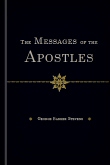
The first 10 epistles of Paul, reproduced in The Messages of the Paul, presented us with the apostle’s doctrinal system. The Pastorals, whatever view may be taken of their authorship, have little bearing upon that system but, instead, deal with relations and conditions that more appropriately place them in the later group of New Testament writings. This volume comprises a paraphrase of the rest of the New Testament epistles, arranged in their probable chronological order, with brief introductions and analysis.
The Messages of the Apostles contains an analysis and paraphrase of the following epistles:
- The Recorded Sermons of the Apostles
- The Epistle of James
- The First Epistle of Peter
- The Epistle of Jude
- The Second Epistle of Peter
- The First Epistle of Timothy
- The Epistle of Titus
- The Second Epistle of Timothy
- The Epistle to the Hebrews
- The First Epistle of John
- The Second Epistle of John
- The Third Epistle of John
George Barker Stevens (1854–1906) was Dwight Professor of Systematic Theology at Yale University. His numerous works include The Theology of the New Testament, A Short Exposition of the Epistle to the Galatians, The Christian Doctrine of Salvation, and The Teaching of Jesus.
Reviews
10 ratings

David Anfinrud
11/2/2024
OVerall an interesting set of books. FInd it refreshing reading in some areas. Have not read all of them but good summaries of various passages I have read. Not detailed commentary but big picture commentary and thinking of various aspects of the Bible. Message of the poets is very interesting and gets out the poems all over the Old Testament . nice expositions within the poems. IT is something worth looking into if you own it.Phil Niebergall
1/10/2020
Dave St. Hilaire
7/29/2015

Dustin Payne
9/27/2014
AeliusCicero
6/19/2014

Larry Proffitt (I
11/5/2013

Whyndell Grizzard
9/4/2013

Bill Shewmaker
8/16/2013

Raymond Sevilla
7/19/2013

Terry Lawson
7/15/2013